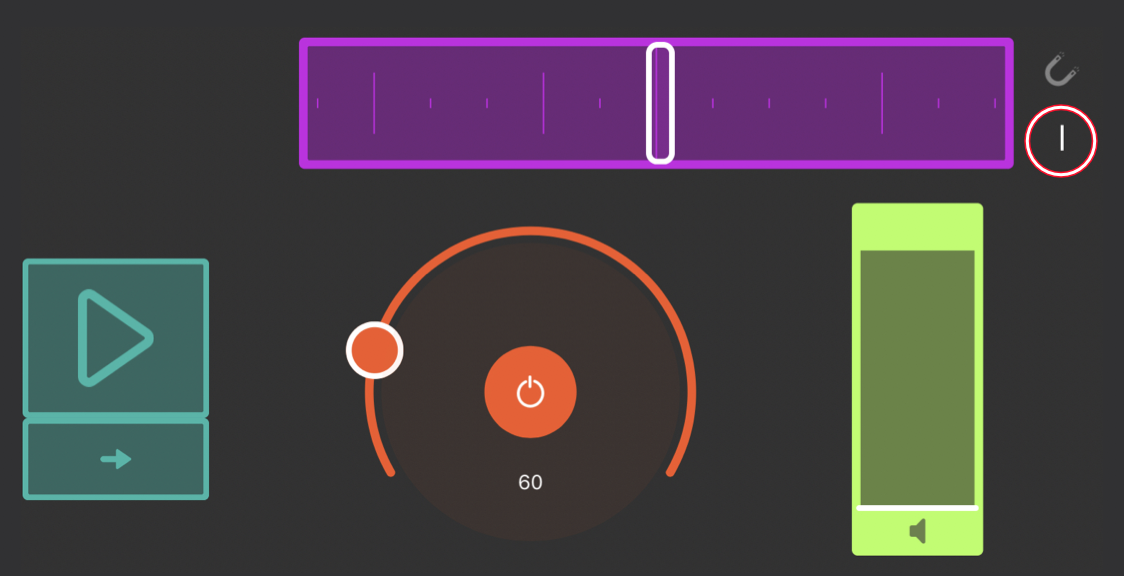glide
Main content: Glissando in contrary-motion
Pedagogical objectives
- The student is able to create a smooth glissandoA glissando is a musical term of Italian origin that designates the continuous sliding of a sound in an upward or downward movement. The glissando can be produced by the human voice and, among other things, by stringed instruments and the slide trombone. A glissando effect can be produced on fixed pitch instruments such as the piano and the harp....
- The student is able to distinguish at any given moment, a unisonA group of different sounds at the same frequency., a clusterA cluster (tightly grouped voices) consists of a set of simultaneous sounds at the musical interval of a quarter tone or less. or an octave.
Pedagogical intentions
- Familiarize the students with the glissandoA glissando is a musical term of Italian origin that designates the continuous sliding of a sound in an upward or downward movement. The glissando can be produced by the human voice and, among other things, by stringed instruments and the slide trombone. A glissando effect can be produced on fixed pitch instruments such as the piano and the harp... process.
- Introduce students to notions related to the superimposition of pitches (clusterA cluster (tightly grouped voices) consists of a set of simultaneous sounds at the musical interval of a quarter tone or less., microtonality, unisonA group of different sounds at the same frequency., harmonic relations).
- Improve the students’ pitch discrimination.
- Help students master the glissandoA glissando is a musical term of Italian origin that designates the continuous sliding of a sound in an upward or downward movement. The glissando can be produced by the human voice and, among other things, by stringed instruments and the slide trombone. A glissando effect can be produced on fixed pitch instruments such as the piano and the harp... technique with gestures using the speed/pitch tool.

Tools
Example

En option: on active le [métronome], entre 100 et 200, ce qui crée un son continu.

École Au-Coeur-Des-Monts, St-Pie, Québec. Enseignant : Jean-François Senécal
Process
Ref. Iannis Xenakis, Metastasis, (1953/54)
Divide the group in two.
- The teacher proposes a sustained “tonic” sound such as [aaaaaa], from the bank “Human sounds”.
- The conductor (teacher or student) initiates a unisonA group of different sounds at the same frequency. by adding one student at a time.
- The conductor directs a slow glissandoA glissando is a musical term of Italian origin that designates the continuous sliding of a sound in an upward or downward movement. The glissando can be produced by the human voice and, among other things, by stringed instruments and the slide trombone. A glissando effect can be produced on fixed pitch instruments such as the piano and the harp... in contrary-motion, one group descending and the other ascending. Trigger each glissandoA glissando is a musical term of Italian origin that designates the continuous sliding of a sound in an upward or downward movement. The glissando can be produced by the human voice and, among other things, by stringed instruments and the slide trombone. A glissando effect can be produced on fixed pitch instruments such as the piano and the harp..., one after the other in order to assure the “clusterA cluster (tightly grouped voices) consists of a set of simultaneous sounds at the musical interval of a quarter tone or less.” effect.
- Assessment: were the gestures of the conductor followed faithfully? Was it possible during the exercise, to perceive when the sounds created a unisonA group of different sounds at the same frequency., a clusterA cluster (tightly grouped voices) consists of a set of simultaneous sounds at the musical interval of a quarter tone or less., micro-intervals, an octave?
Proposal for a creative activity
- The teacher asks the students to imagine a scenario involving sliding sounds (glissandoA glissando is a musical term of Italian origin that designates the continuous sliding of a sound in an upward or downward movement. The glissando can be produced by the human voice and, among other things, by stringed instruments and the slide trombone. A glissando effect can be produced on fixed pitch instruments such as the piano and the harp...). For example, create a calm, night ambiance. Many shooting stars streak through the sky. Imagine the “sound” of the Northern Lights… For inspiration, listen to the sounds in the sound-bank “Sliding sounds”.
- Once a scenario is agreed upon, each student must find or (better still) create appropriate sounds.
- Decide as a group, how to start. Create the ambiance by carefully listening to one another.












